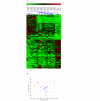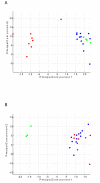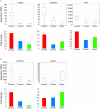Effect of active smoking on the human bronchial epithelium transcriptome
- PMID: 17727719
- PMCID: PMC2001199
- DOI: 10.1186/1471-2164-8-297
Effect of active smoking on the human bronchial epithelium transcriptome
Abstract
Background: Lung cancer is the most common cause of cancer-related deaths. Tobacco smoke exposure is the strongest aetiological factor associated with lung cancer. In this study, using serial analysis of gene expression (SAGE), we comprehensively examined the effect of active smoking by comparing the transcriptomes of clinical specimens obtained from current, former and never smokers, and identified genes showing both reversible and irreversible expression changes upon smoking cessation.
Results: Twenty-four SAGE profiles of the bronchial epithelium of eight current, twelve former and four never smokers were generated and analyzed. In total, 3,111,471 SAGE tags representing over 110 thousand potentially unique transcripts were generated, comprising the largest human SAGE study to date. We identified 1,733 constitutively expressed genes in current, former and never smoker transcriptomes. We have also identified both reversible and irreversible gene expression changes upon cessation of smoking; reversible changes were frequently associated with either xenobiotic metabolism, nucleotide metabolism or mucus secretion. Increased expression of TFF3, CABYR, and ENTPD8 were found to be reversible upon smoking cessation. Expression of GSK3B, which regulates COX2 expression, was irreversibly decreased. MUC5AC expression was only partially reversed. Validation of select genes was performed using quantitative RT-PCR on a secondary cohort of nine current smokers, seven former smokers and six never smokers.
Conclusion: Expression levels of some of the genes related to tobacco smoking return to levels similar to never smokers upon cessation of smoking, while expression of others appears to be permanently altered despite prolonged smoking cessation. These irreversible changes may account for the persistent lung cancer risk despite smoking cessation.
Figures





Comment in
-
Correspondence regarding "Effect of active smoking on the human bronchial epithelium transcriptome".BMC Genomics. 2009 Feb 18;10:82. doi: 10.1186/1471-2164-10-82. BMC Genomics. 2009. PMID: 19224643 Free PMC article.
Similar articles
-
Identification of novel lung genes in bronchial epithelium by serial analysis of gene expression.Am J Respir Cell Mol Biol. 2006 Dec;35(6):651-61. doi: 10.1165/rcmb.2006-0056OC. Epub 2006 Jun 29. Am J Respir Cell Mol Biol. 2006. PMID: 16809635
-
Current smoking-specific gene expression signature in normal bronchial epithelium is enhanced in squamous cell lung cancer.J Pathol. 2009 Jun;218(2):182-91. doi: 10.1002/path.2520. J Pathol. 2009. PMID: 19334046
-
Smoking and cancer-related gene expression in bronchial epithelium and non-small-cell lung cancers.J Pathol. 2006 Oct;210(2):192-204. doi: 10.1002/path.2039. J Pathol. 2006. PMID: 16915569
-
Correspondence regarding "Effect of active smoking on the human bronchial epithelium transcriptome".BMC Genomics. 2009 Feb 18;10:82. doi: 10.1186/1471-2164-10-82. BMC Genomics. 2009. PMID: 19224643 Free PMC article.
-
Characterizing the impact of smoking and lung cancer on the airway transcriptome using RNA-Seq.Cancer Prev Res (Phila). 2011 Jun;4(6):803-17. doi: 10.1158/1940-6207.CAPR-11-0212. Cancer Prev Res (Phila). 2011. PMID: 21636547 Free PMC article.
Cited by
-
The effects of cigarette smoking extracts on cell cycle and tumor spread: novel evidence.Future Sci OA. 2019 May 3;5(5):FSO394. doi: 10.2144/fsoa-2019-0017. Future Sci OA. 2019. PMID: 31205749 Free PMC article. Review.
-
Cigarette smoke differentially affects IL-13-induced gene expression in human airway epithelial cells.Physiol Rep. 2017 Jul;5(13):e13347. doi: 10.14814/phy2.13347. Epub 2017 Jul 11. Physiol Rep. 2017. PMID: 28701525 Free PMC article.
-
MicroRNA 4423 is a primate-specific regulator of airway epithelial cell differentiation and lung carcinogenesis.Proc Natl Acad Sci U S A. 2013 Nov 19;110(47):18946-51. doi: 10.1073/pnas.1220319110. Epub 2013 Oct 24. Proc Natl Acad Sci U S A. 2013. PMID: 24158479 Free PMC article.
-
Transcriptomic studies of the airway field of injury associated with smoking-related lung disease.Proc Am Thorac Soc. 2011 May;8(2):173-9. doi: 10.1513/pats.201011-066MS. Proc Am Thorac Soc. 2011. PMID: 21543797 Free PMC article.
-
Relation between smoking history and gene expression profiles in lung adenocarcinomas.BMC Med Genomics. 2012 Jun 7;5:22. doi: 10.1186/1755-8794-5-22. BMC Med Genomics. 2012. PMID: 22676229 Free PMC article.
References
-
- Jemal A, Siegel R, Ward E, Murray T, Xu J, Smigal C, Thun MJ. Cancer statistics, 2006. CA Cancer J Clin. 2006;56:106–130. - PubMed
Publication types
MeSH terms
Substances
Grants and funding
LinkOut - more resources
Full Text Sources
Other Literature Sources
Molecular Biology Databases
Research Materials
Miscellaneous

